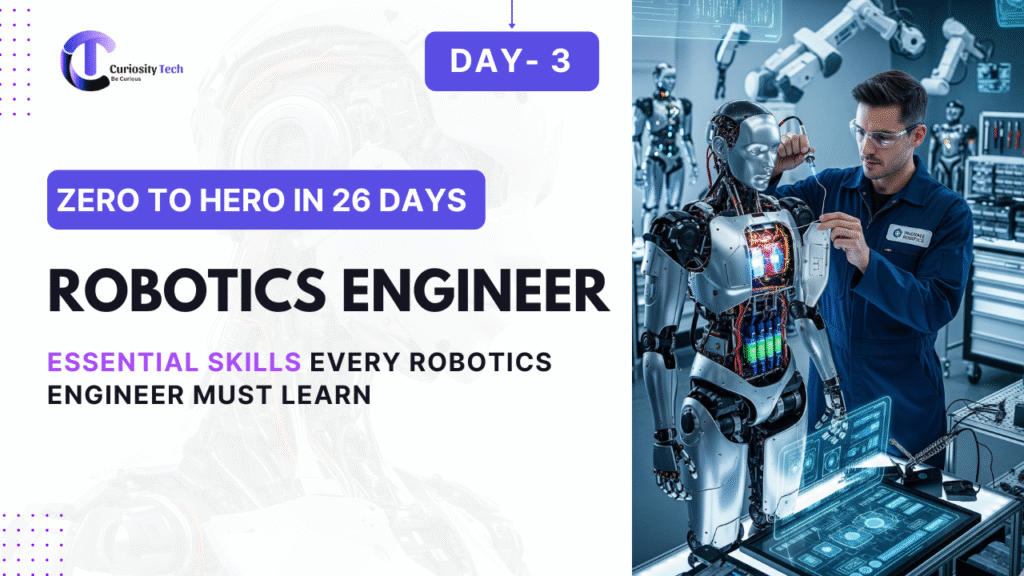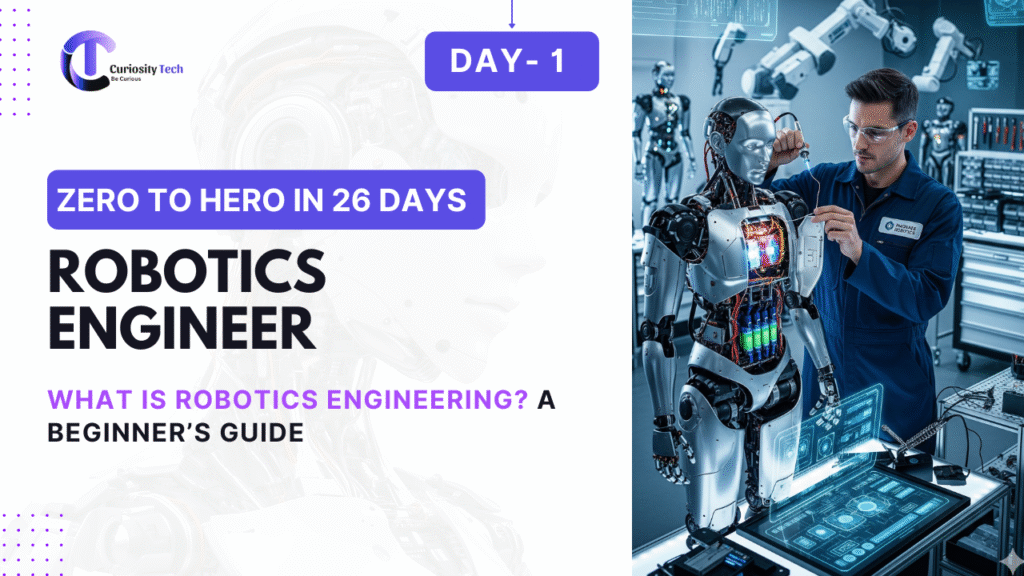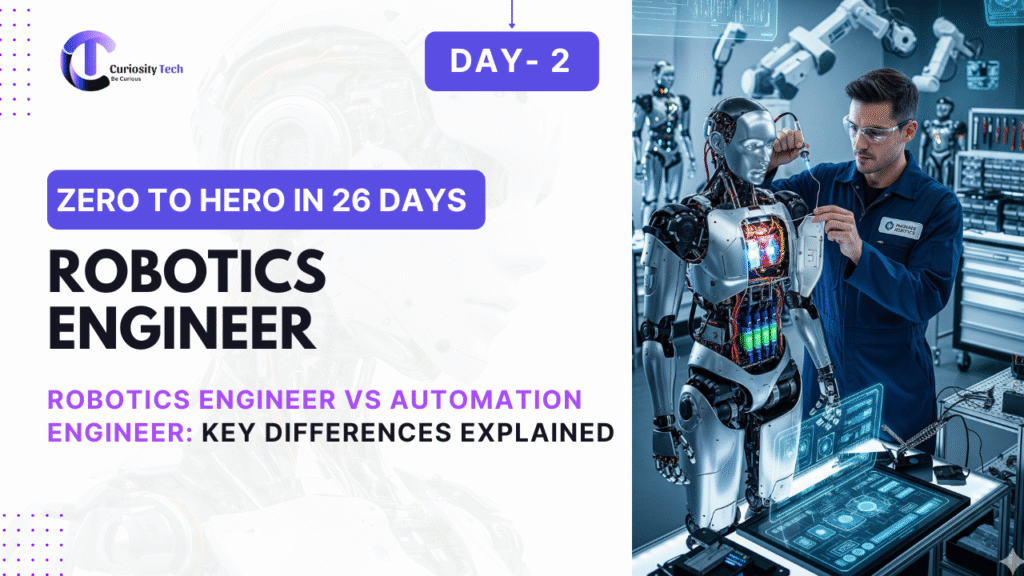Introduction
A career in robotics engineering demands a diverse and specialized skill set. Unlike traditional engineering fields, robotics combines mechanical design, electronics, embedded systems, software programming, and artificial intelligence. Aspiring robotics engineers must develop a balance of theoretical knowledge and hands-on practical expertise to excel.
At CuriosityTech.in, learners can access a variety of tutorials, projects, and resources that help build these skills incrementally—from beginner-friendly exercises to advanced robotics applications.
Core Technical Skills for Robotics Engineers
1. Mechanical Design & Engineering
Understanding mechanics is fundamental. A robotics engineer must master:
- Kinematics: Movement of robots, forward & inverse kinematics.
- Dynamics: Forces, torque, and motion planning.
- CAD Tools: SolidWorks, AutoCAD, or Fusion 360 for robot modeling.
- Material Science: Choosing materials for weight, strength, and durability.
Practical Tip: Start with small robotic arms or mobile robot kits to understand how joints, linkages, and actuators work.
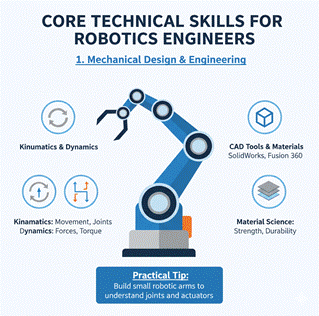
2. Electronics & Embedded Systems
Robots rely on electronic components for sensing and actuation:
- Sensors: LiDAR, ultrasonic, infrared, IMUs, cameras.
- Actuators: Servo motors, stepper motors, linear actuators.
- Microcontrollers: Arduino, Raspberry Pi, STM32.
- Circuit design and PCB basics for integrating sensors and controllers.
CuriosityTech.in provides step-by-step guides to build microcontroller-based robots, bridging theory with practical implementation.
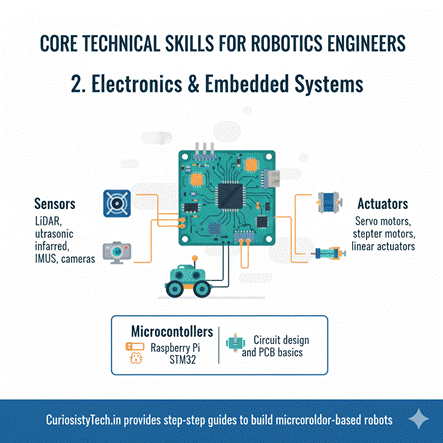
3. Programming & Software Development
Programming is the brain of a robot:
- Languages: C, C++, Python (ROS integration), MATLAB.
- Robot Operating System (ROS): Framework for robot control, communication, and simulation.
- AI & Machine Learning: Object detection, navigation, reinforcement learning.
Practical Tip: Implement a line-following robot in Python first, then add AI-based obstacle avoidance using OpenCV.
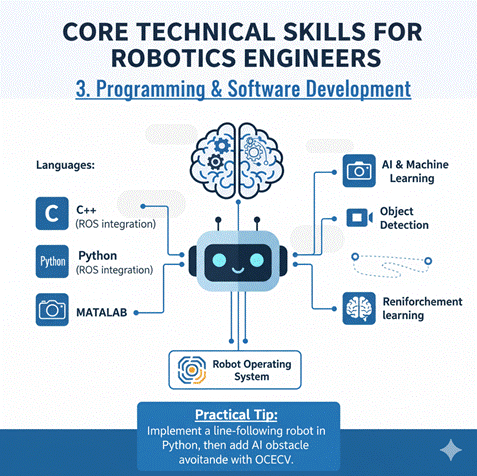
4. Control Systems
Robots require precise motion control:
- PID Controllers: Basics of feedback and tuning for stability.
- Adaptive Control: Handling changing environments or loads.
- State Estimation: Kalman filters, sensor fusion techniques.
Diagram Idea:
Sensors → Controller → Actuators → Robot Motion → Feedback Loop
Description: The feedback loop ensures robots respond accurately to environmental inputs.
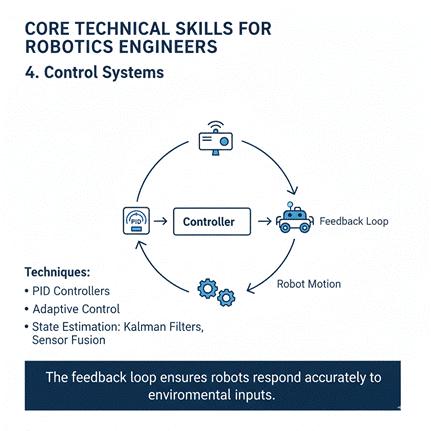
5. Artificial Intelligence & Machine Learning
Modern robotics heavily integrates AI for autonomy:
- Path Planning: Dijkstra, A*, RRT algorithms.
- SLAM (Simultaneous Localization and Mapping): Mapping unknown environments.
- Computer Vision: OpenCV, YOLO, TensorFlow for object recognition.
- Decision Making: Reinforcement learning for adaptive behavior.
Practical Exercise: Use a Raspberry Pi robot with a camera to detect obstacles and navigate autonomously using OpenCV and Python.
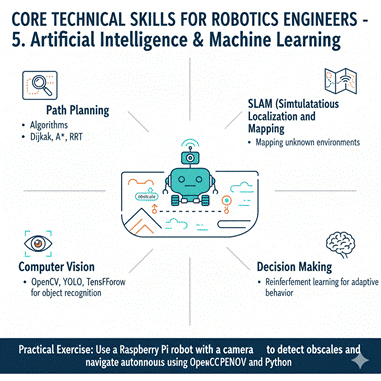
Skill Roadmap Table
| Skill Category | Beginner Level | Intermediate Level | Advanced Level |
| Mechanical Engineering | Basic CAD modeling, linkages | Kinematics, dynamics, actuators | Advanced robotics arm design |
| Electronics & Embedded | Arduino LED & motor projects | Sensor integration, Raspberry Pi projects | Custom PCB, microcontroller optimization |
| Programming | Python/C++ basics | ROS integration, object detection | AI & ML integration, autonomous behavior |
| Control Systems | PID controller basics | State estimation, sensor fusion | Adaptive & predictive control systems |
| AI & ML | Object recognition | Path planning & SLAM | Reinforcement learning, autonomous decision making |
Infographic: Robotics Skill Pyramid
- Base Layer: Mechanical + Electronics (Foundation)
- Middle Layer: Programming + Control Systems (Application)
- Top Layer: AI & ML (Autonomy & Innovation)
Description: The pyramid illustrates skill progression—strong foundation is essential for advanced autonomous robotics development.
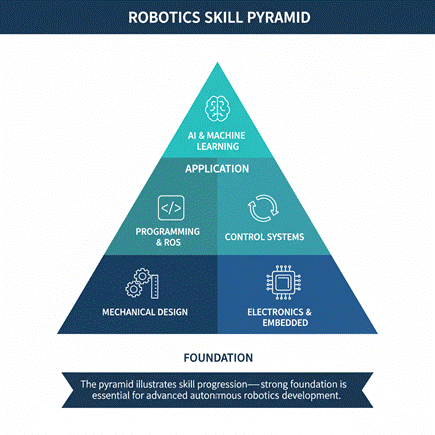
Soft Skills for Robotics Engineers
- Problem-Solving: Debugging both hardware and software.
- Project Management: Managing timelines for multi-component projects.
- Collaboration: Working with multidisciplinary teams—mechanical, electrical, and software engineers.
- Continuous Learning: Robotics is rapidly evolving; staying updated with tools, libraries, and AI advancements is mandatory.
Hands-On Learning with CuriosityTech.in
CuriosityTech.in emphasizes practical projects to consolidate skills:
- Mobile robots for line-following and obstacle avoidance.
- Sensor integration projects for environmental perception.
- AI-driven projects for autonomous navigation and image processing.
By combining guided tutorials and self-driven experiments, learners develop both confidence and technical mastery.
Conclusion
To become an expert robotics engineer, you must cultivate a blend of mechanical, electronic, programming, and AI skills, along with essential soft skills like problem-solving and collaboration. The journey is iterative, starting from small projects to advanced autonomous systems. Platforms like CuriosityTech.in provide comprehensive support, ensuring that beginners and intermediate learners can transform curiosity into expertise.

